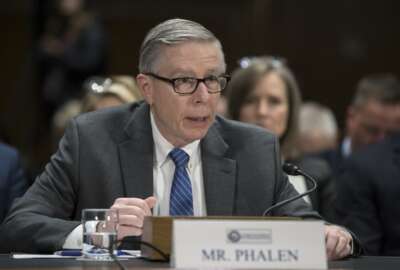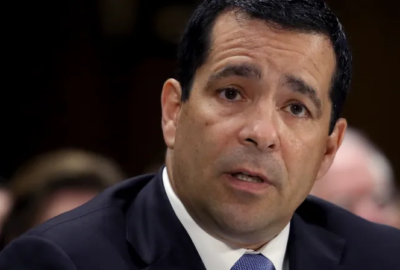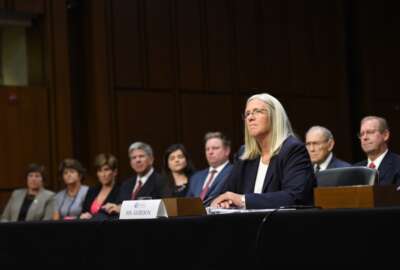
Agencies losing time, talent and money due to security clearance reciprocity challenges
Industry leaders say up to 10% of their cleared intelligence community workforces are idle at any given time, because they're waiting for agencies to grant, update...
Ambiguous, layered and outdated policies and practices are preventing federal employees and contractors with security clearances from moving top talent in and around government.
Government is losing talent, productivity and taxpayer dollars as agencies often take several months to complete their own investigations of individuals who have already been reviewed and cleared by another federal organization, the Intelligence and National Security Alliance said in a recent report describing the challenges with a concept known as “reciprocity.”
“Reciprocity” refers to the idea that if one agency places trust and grants a security clearance to a federal employee or contractor, most other agencies — generally — should too.
But members of industry have, on multiple occasions, said this isn’t standard practice at some departments, and contractors generally have little insight into where their employees are in an agency’s investigative and adjudication process, INSA said.
Industry leaders say 10% of their cleared contractor workforce within the intelligence community are idle at any given time, because their employees are waiting for an agency to grant, update or transfer a security clearance. INSA estimates these reciprocity delays could total as much as 1,000 lost contractor labor-years and $2 billion a year, assuming an average annual cost of $200,000 per top-secret cleared contractor to the government.
Reciprocity delays across government could amount to some 90,000 lost contractor labor-years, according to INSA’s estimates.
“Industry currently has many thousands of personnel who were cleared on one government contract but who must wait weeks or months before being allowed to work on a new contract,” INSA wrote. “One large firm alone reported that it currently had more than 700 employees waiting for clearance transfers, and that on average its employees wait 94 days for their clearances to be accepted by a new agency.”
The Office of the Director of National Intelligence has tried to provide more clarity. ODNI’s Security Executive Agent issued a directive back in November 2018, which said agencies should “accept” existing security clearances and national security eligibility adjudications and determinations already granted by another executive branch agency.
But directives like this most recent one, INSA argued, give agencies too much room to interpret their own meanings, and in fact, they have.
“Individual agencies created internal policies and procedures based on their own interpretations of [Security Executive Agent] directives,” INSA’s report reads. “At larger agencies like the DoD, sub-departments including the Army, Navy and Air Force have further promulgated their own interpretations of both ODNI and DoD policy. This practice of agency-specific policy interpretation creates a web of inconsistent rules that complicate reciprocal recognition of clearances.”
In addition, the directive doesn’t mention how agencies should handle previous policies on security clearance reciprocity, which have been equally ambiguous on the topic, INSA said.
Recommendations for reciprocity policy, adjudication timeliness
Related Stories

As NBIB shrinks the security clearance backlog, other personnel vetting agencies feel the pressure
“Right now we have a lot of work to do in establishing common standards,” Charlie Allen, a senior intelligence adviser and chair of INSA’s security policy reform council, said in an interview. “On reciprocity, we have significant inconsistency when it comes to policies and standards. We have a lack of transparency and information sharing, which bothers me significantly. The lack of information sharing really creates distrust when we don’t share information as we bring these people on.”
Allen previously served as the first undersecretary for intelligence and analysis at the Department of Homeland Security after a decades-long career at the CIA.
Federal adjudication facilities also need more resources to more quickly sign off on completed background investigations, INSA suggested.
Allen described the adjudication process in general as a “painful and slow process,” and the latest timeliness data from Performance.gov prove his point.
Initial secret and top secret cases on average took 30 and 42 days, respectively, to adjudicate in the second quarter of fiscal 2019, according to a June update on Performance.gov. Periodic re-investigations took 100 days to adjudicate, data which is likely skewed to reflect recent Defense Department policy to forego those reviews in favor of continuous vetting.
Though not new to the intelligence and defense communities, continuous vetting is still an emerging concept for other agencies, and INSA argued it could also open up more uncertainty for security clearance reciprocity.
Adjudications are supposed to be completed in an average of 20 days, according to methodology from the Performance Accountability Council.
The Defense Department’s Consolidated Adjudications Facility has, in part, recognized its challenges to keep up with the National Background Investigations Bureau. But as NBIB has cut the backlog of pending investigatory matters by nearly 40 percent within the last year or so, that pace creates more pressure for DoD’s CAF to adjudicate more cases.
Though INSA described several existing challenges and made more than a dozen recommendations to clear up existing policies and create new ones, the organization is optimistic government will eventually act.
The reform council hosts meetings with industry, congressional staffers and senior government leaders like Principal Deputy Director of National Intelligence Sue Gordon, who discuss these challenges and coming security clearance policy plans. These discussions show all the appropriate parties are interested and engaged in improving the security clearance process, Allen said.
ODNI and the Office of Personnel Management are working on a top-to-bottom overhaul of the suitability, credentialing and security clearance processes as part of a “Trusted Workforce 2.0” initiative.
New standards for denying, suspending and revoking federal credentials were due last summer but new deadlines have been set, according to the recent Performance.gov update.
These initiatives, as well as the administration’s plans to transfer the entire security clearance, suitability and credentialing enterprise from OPM and NBIB to the Pentagon, has industry feeling optimistic about the prospects for true modernization.
“I believe it can be done,” Allen said. “The White House has to stay engaged. It can’t be something the White House throws over the fence.”
Some members of Congress have also recognized the need for modernization.
Sen. Mark Warner (D-Va.) is the author of several provisions designed to ensure agencies are meeting reciprocity guidelines and more easily transfer cleared individuals in and around government.
These provisions are part of the 2020 defense authorization bill, which cleared the Senate late last month.
Copyright © 2025 Federal News Network. All rights reserved. This website is not intended for users located within the European Economic Area.
Nicole Ogrysko is a reporter for Federal News Network focusing on the federal workforce and federal pay and benefits.
Follow @nogryskoWFED





